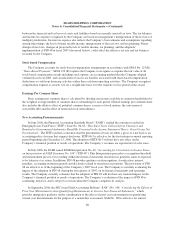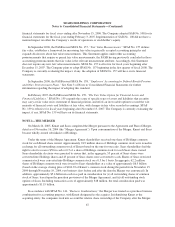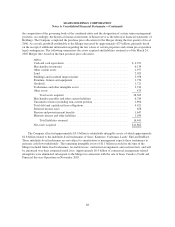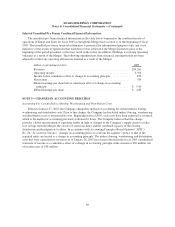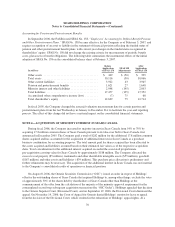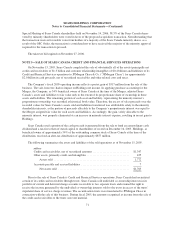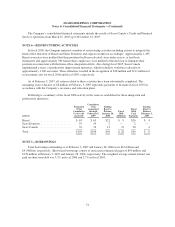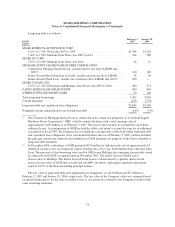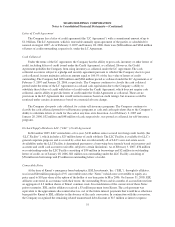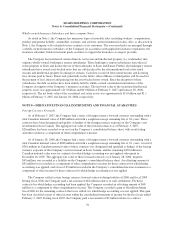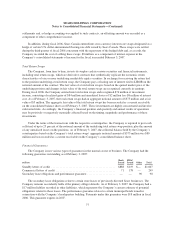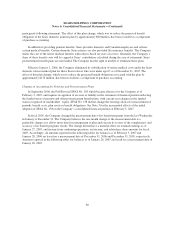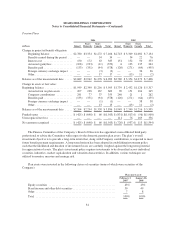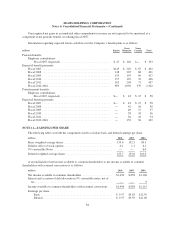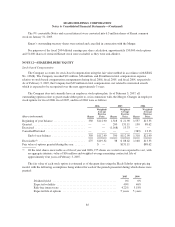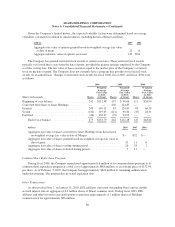Sears 2006 Annual Report Download - page 76
Download and view the complete annual report
Please find page 76 of the 2006 Sears annual report below. You can navigate through the pages in the report by either clicking on the pages listed below, or by using the keyword search tool below to find specific information within the annual report.SEARS HOLDINGS CORPORATION
Notes to Consolidated Financial Statements—(Continued)
Wholly-owned Insurance Subsidiary and Inter-company Notes
As noted in Note 1, the Company has numerous types of insurable risks, including workers’ compensation,
product and general liability, automobile, warranty, and asbestos and environmental claims. Also, as discussed in
Note 1, the Company sells extended service contracts to its customers. The associated risks are managed through
a wholly-owned insurance subsidiary of the Company. In accordance with applicable insurance regulations, the
insurance subsidiary holds investment grade securities to support the insurance coverage it provides.
The Company has transferred certain domestic real estate and intellectual property (i.e. trademarks) into
separate wholly-owned, bankruptcy remote subsidiaries. These bankruptcy remote subsidiaries lease the real
estate property to Sears and license the use of the trademarks to Sears and Kmart. Further, the bankruptcy remote
subsidiaries have issued asset-backed notes that are collateralized by the aforementioned real estate rental
streams and intellectual property licensing fee streams. Cash flows received from rental streams and licensing
fees streams paid by Sears, Kmart and, potentially in the future, other affiliates or third parties will be used for
the payment of fees, interest and principal on the asset-backed notes issued. Since the inception of these
subsidiaries, the debt securities have been entirely held by wholly-owned consolidated subsidiaries of the
Company in support of the Company’s insurance activities. The net book value of the securitized intellectual
property assets was approximately $1.0 billion and $0.0 billion at February 3, 2007 and January 28, 2006,
respectively. The net book value of the securitized real estate assets was approximately $1.0 billion and $1.1
billion at February 3, 2007 and January 28, 2006, respectively.
NOTE 8—DERIVATIVE FINANCIAL INSTRUMENTS AND FINANCIAL GUARANTEES
Foreign Currency Forwards
As of February 3, 2007, the Company had a series of foreign currency forward contracts outstanding with a
total Canadian notional value of $400 million and with a weighted-average remaining life of 0.4 years. These
contracts have been designated and qualify as hedges of the foreign currency exposure of the Company’s net
investment in Sears Canada. The aggregate fair value of the forward contracts as of February 3, 2007,
$26 million, has been recorded as an asset on the Company’s consolidated balance sheet, with an offsetting
amount recorded as a component of other comprehensive income.
As of January 28, 2006, the Company had a series of foreign currency forward contracts outstanding with a
total Canadian notional value of $800 million and with a weighted-average remaining life of 0.1 years. A total of
$361 million in Canadian notional value of these contracts was designated and qualified as hedges of the foreign
currency exposure of the Company’s net investment in Sears Canada, and the remaining $439 million in
Canadian notional value were for contracts for which hedge accounting was not applied subsequent to
December 16, 2005. The aggregate fair value of these forward contracts as of January 28, 2006, negative
$45 million, was recorded as a liability on the Company’s consolidated balance sheet. An offsetting amount of
$42 million was recorded as a component of other comprehensive income for those contracts for which hedge
accounting was applied, and a loss of $3 million recorded in the Company’s consolidated income statement as a
component of other income for those contracts for which hedge accounting was not applied.
The Company settled certain foreign currency forward contracts during both fiscal 2006 and fiscal 2005.
During fiscal 2006, the Company paid a net amount of $42 million relative to such settlements. For those
contracts for which hedge accounting had been applied, the Company recorded an offsetting amount of $48
million as a component of other comprehensive income. The Company recorded a gain of $6 million during
fiscal 2006 for the remaining contracts that were settled, for which hedge accounting was not applied. This gain
has been classified as part of other income within the consolidated statement of income for the fiscal year ended
February 3, 2007. During fiscal 2005, the Company paid a net amount of $9 million relative to contract
76


